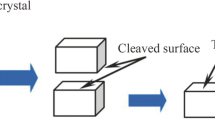Abstract
It has been a tremendous challenge to manufacture damage-free and smooth surfaces of potassium dihydrogen phosphate (KDP) crystals to meet the requirements of high-energy laser systems. The intrinsic issue is whether a KDP crystal can be plastically deformed so that the material can be removed in a ductile mode during the machining of KDP. This study investigates the room temperature creep-deformation of KDP crystals with the aid of nanoindentation. A stress analysis was carried out to identify the creep mechanism. The results showed that KDP crystals could be plastically deformed at the nano-scale. Dislocation motion is responsible for creep-deformation. Both creep rate and creep depth decrease with decrease in peak force and loading rate. Dislocation nucleation and propagation bring about pop-ins in the load-displacement curves during nanoindentation.














Similar content being viewed by others
References
de Yoreo J, Burnham AK, Whitman PK (2002) Developing KH2PO4 and KD2PO4 crystals for the world’s most power laser. Int Mater Rev 47(3):113–152
Hawley-Fedder RA, Geraghty P, Locke SN et al (2004) NIF pockels cell and frequency conversion crystals. Int Soc Opt Photon. https://doi.org/10.1117/12.538482
Chen WQ, Lu LH, Liang YC et al (2015) Flatness improving method of KDP crystal in ICF system and its implementation in machine tool design. Proc Inst Mech Eng Part E J Process Mech Eng 229(4):327–332
Chen GD, Sun YZ, An CH et al (2016) Measurement and analysis for frequency domain error of ultra-precision spindle in a flycutting machine tool. Proc Inst Mech Eng Part B J Eng Manuf. https://doi.org/10.1177/0954405416673102
Chen GD, Sun YZ, Zhang FH et al (2017) Influence of ultra-precision flycutting spindle error on surface frequency domain error formation. Int J Adv Manuf Technol 88(9–12):3233–3241
Fang T, Lambropoulos JC (2002) Microhardness and indentation fracture of potassium dihydrogen phosphate (KDP). J Am Ceram Soc 85(1):174–178
Kucheyev SO, Siekhaus WJ, Land TA et al (2004) Mechanical response of KD2xH2(1−x)PO4 crystals during nanoindentation. Appl Phys Lett 84(13):2274–2276
Guo XG, Zhang XJ, Tang XZ et al (2013) Nanoindentation on the doubler plane of KDP single crystal. J Semicond 34(3):034001
Lu C, Gao H, Wang J et al (2010) Mechanical properties of potassium dihydrogen phosphate single crystal by the nanoindentation technique. Mater Manuf Processes 25(8):740–748
Joshi MS, Antony AV, Rao PM (1980) Microhardness investigations on potassium dihydrogen phosphate crystals. Cryst Res Technol 15(6):743–746
Zhang Y, Zhang L, Liu M et al (2016) Revealing the mechanical properties of potassium dihydrogen phosphate crystals by nanoindentation. J Mater Res 31(8):1–9
Guin CH, Katrich MD, Savinkov AI et al (1980) Plastic strain and dislocation structure of the KDP group crystals. Cryst Res Technol 15(4):479–488
Peng J, Zhang LC, Lu XC (2013) Elastic-plastic deformation of KDP crystals under nanoindentation. Mater Sci Forum 773–774:705–711
Raman V, Berriche R (1992) An investigation of the creep processes in tin and aluminum using a depth-sensing indentation technique. J Mater Res 7(3):627–638
Mahmudi R, Roumina R, Raeisinia B (2004) Investigation of stress exponent in the power-law creep of Pb-Sb alloys. Mater Sci Eng A 382(1–2):15–22
Fu YJ, Gao ZS, Sun X et al (2000) Effects of anions on rapid growth and growth habit of KDP crystals. Prog Cryst Growth Charact Mater 40(1–4):211–220
Li H, Ngan AHW (2004) Size effects of nanoindentation creep. J Mater Res 19(02):513–522
Wang CL, Zhang M, Nieh TG (2009) Nanoindentation creep of nanocrystalline nickel at elevated temperatures. J Phys D Appl Phys 42(11):115405
Pešička J, Kužel R, Dronhofer A et al (2003) The evolution of dislocation density during heat treatment and creep of tempered martensite ferritic steels. Acta Mater 51(16):4847–4862
Pelleg J (2013) Mechanical properties of materials. Springer, Dordrecht
William D, Callister J, David G et al (2009) Materials science and engineering: an introduction. Wiley, New Jersey, pp 265–268
Lucas BN, Oliver WC (1999) Indentation power-law creep of high-purity indium. Metall Mater Trans A 30(3):601–610
Hosford WF (1967) Mechanical behavior of materials. Mater Today 20(5):83–85
Meyers MA, Chawla KK (2009) Mechanical behavior of materials. Cambridge University Press, Cambridge, pp 673–674
Hou N, Zhang Y, Zhang L et al (2016) Assessing microstructure changes in potassium dihydrogen phosphate crystals induced by mechanical stresses. Scripta Mater 113:48–50
Cao Z, Ju X, Yan C et al (2015) Synchrotron micro-XRF study of metal inclusions distribution in potassium dihydrogen phosphate (KDP) induced by ultraviolet laser pulses. Opt Mater Express 5(10):2201–2208
Johnson KL (1970) The correlation of indentation experiments. J Mech Phys Solids 18(2):115–126
Li WB, Henshall JL, Hooper RM et al (1991) The mechanisms of indentation creep. Acta Metal Mater 39(12):3099–3110
Frost HJ, Ashby MF (1982) Deformation mechanism maps: the plasticity and creep of metals and ceramics. Pergammon Press, Oxford
Alden TH (1987) Theory of mobile dislocation density: application to the deformation of 304 stainless steel. Metall Trans 18A:51–62
Wang SH, Chen W (2001) Room temperature creep deformation and its effect on yielding behaviour of a line pipe steel with discontinuous yielding. Mater Sci Eng A 301(2):147–153
Chang L, Zhang L (2009) Mechanical behaviour characterization of silicon and effect of loading rate on pop-in: a nanoindentation study under ultra-low loads. Mater Sci Eng A 506:125–129
Borc J, Sangwal K, Pritula I et al (2017) Investigation of pop-in events and indentation size effect on the (001) and (100) faces of KDP crystals by nanoindentation deformation. Mater Sci Eng A 708:1–10
Acknowledgement
This work was financially sponsored by the National Nature Science Foundation of China (Grant Nos. 51875137 and 51375122), Heilongjiang Natural Science Foundation (Grant No. E2018033) and Australian Research Council (Grant No. DP170100567).
Author information
Authors and Affiliations
Corresponding authors
Rights and permissions
About this article
Cite this article
Zhang, Y., Hou, N. & Zhang, LC. Investigation into the room temperature creep-deformation of potassium dihydrogen phosphate crystals using nanoindentation. Adv. Manuf. 6, 376–383 (2018). https://doi.org/10.1007/s40436-018-0234-9
Received:
Accepted:
Published:
Issue Date:
DOI: https://doi.org/10.1007/s40436-018-0234-9




